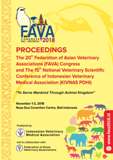PCS-1 Development of Mouse Parthenogenetic Embryos in Phosphate Free Medium
Abstract
Parthenogenesis is an artificial oocytes activation process without paternal contribution so that embryos will develop without fertilization [3]. The process of parthenogenesis as a reproductive strategy occurs in species of insect, pisces, or amphibian, which not require any implantation. Naturally, parthenogenesis is not common in mammals, but by understanding cellular mechanism during fertilization, it is possible to artificially activate mammalian oocytes.
Blastocyst, derived from parthenogenesis, can be used for developmental study, embryo reconstruction, and one of potential source for pluripotent stem cells. Unfortunately, previous studies reported that parthenogenetic embryo did not achieve exhilarating blastocyst rate.
One of the component that has been predicted to inhibit parthenogenetic embryo development is phosphate. Haraguchi et al. (1996) reported that phosphate caused a negative effect on in vitro culture of AKR/N mice fertilized embryos, removal of phosphate elements was significantly improved the blastocyst rate up to 42.6% [1]. The effects of phosphate also became an interesting finding in the study that reported mouse fertilized embryos could well developed in modified medium rat 1 cell embryo medium (MR1ECM) which not contained any phosphate [2].
The effect of phosphate on in vitro culture of mouse parthenogenetic embryo has not been clear. The aim of this research was to analyze inhibitory effect caused by phosphate in the medium and compare the development pattern between parthenogenetic and fertilized embryos in order to reach optimal production of parthenogenetic blastocyst for further purposes.

